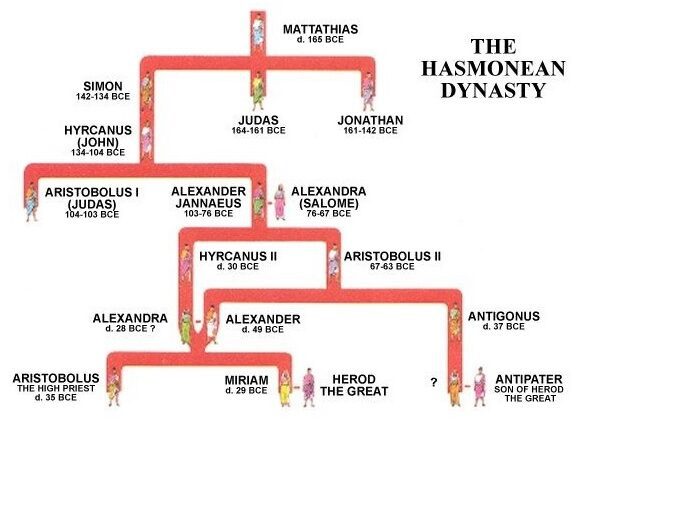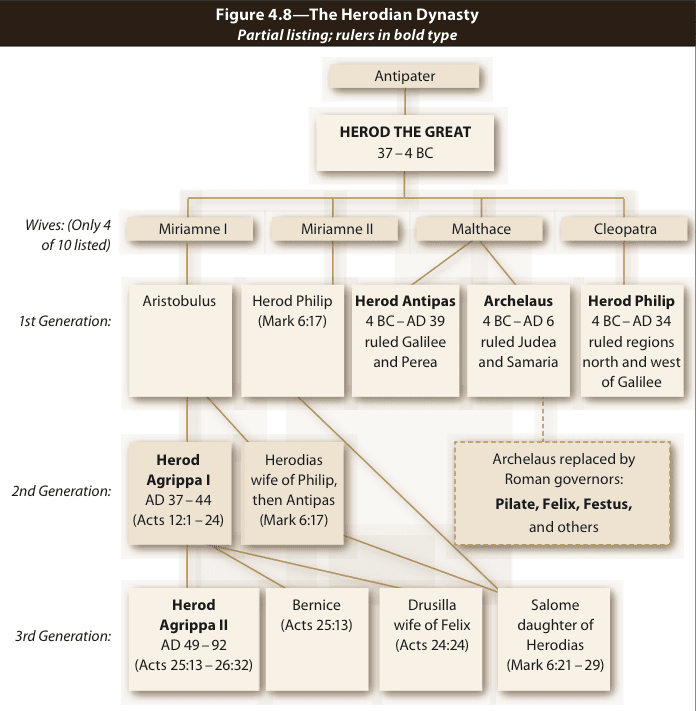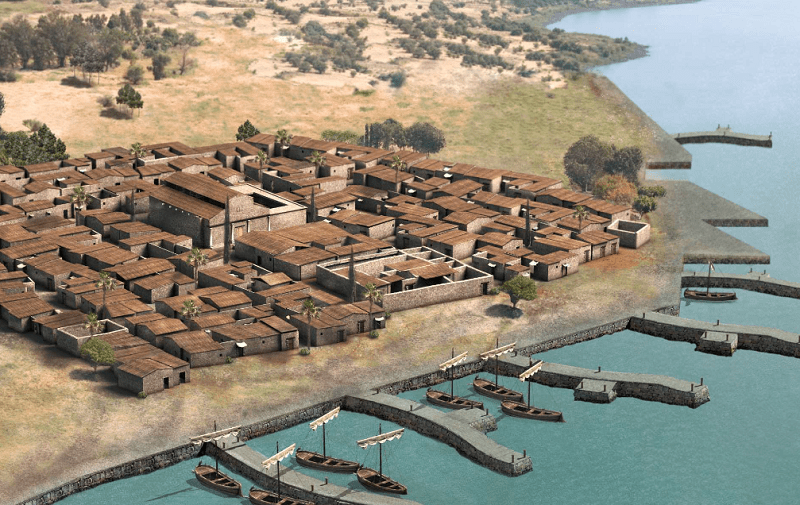Answer Key
- In which decade was Christ most likely crucified and Risen?
- A.D. 30’s, most likely between AD29-AD33
- Which Gospels had Jewish authors?
- Matthew & John [Mark & Luke are gentile believers]
- What was Jesus’ hometown after Nazareth?
- Capernaum in Galilee on Lake Tiberias (Sea of Galilee)
- What year did Rome burn down the Temple and destroy Jerusalem?
- A.D. 70
- Who was the last Apostle to survive into old age?
- The Apostle John, youngest of the Twelve and only Disciple to escape martyrdom.

You will find the answer to the bonus question after the chronology below of events in Rome & Jerusalem. See their relevance to early readers of John's Gospel. In the link below you may find additional answers to the 'who's who' of Rome & Jerusalem of the 1st c. A.D.
1st c. A.D. – Events
The Herodian dynasty began with Herod the Great!


Rome
Jews had migrated to Rome after Julius Caesar made their religion legal. In new cities of the Roman Empire Jews traded with other merchants also supplying expansion of Roman influence into disputed provinces to the east.
- 27 BC- AD 14 Caesar Augustus
- AD 14-37 Tiberias Caesar Augustus, Emperor succeeding Augustus
- AD 34 Tiberias annexes Jewish territories to Syria after death of Philip the tetrarch
- AD 41-54 Caligula, Emperor
- AD 54-68 Nero, Emperor
- A.D. 64 Nero burns Rome for new building projects, blames Christians & causes civil war among Roman citizens and the Army.
- A.D. 66-73 Jewish War against Rome in Judea. Many Jews & Christians flee to other eastern provinces.
- AD 69-79 Vespasian is recalled from Judea and made Emperor of Rome – orders siege of Jerusalem
Judea, Galilee, Syria
In 64 BC the Hasmoneans/Maccabees had negotiated in Damascus in the Roman province of Syria with Pompey of Rome over self-rule. A year later he entered Jerusalem, slaughtering six thousand Jews defending the Temple.
40 B.C. Herod I (the Great) made king by the Romans until his death ~4 B.C.
- Joseph & Mary return from Egypt to Nazareth in Galilee with Jesus.
- A.D. 30 [29-33] JESUS CHRIST CRUCIFIED & RISEN!
Many Jews, gentiles & Romans follow Jesus.
- A.D. ~32 [30-37] Stephen martyred
- A.D. 34-37 Herod Agrippa I made king by Caligula & territories returned
- A.D. 39 Herod Antipas, tetrarch of Galilee forced into exile
- A.D. 42 Paul & Barnabas establish the CHURCH in Antioch, Syria
- A.D. 44 King Herod Agrippa I orders the imprisonment of Paul & many Christians & the beheading of James the brother of John.
- A.D. 54 the Apostle Philip of Bethsaida was scourged, thrown into prison, and afterwards crucified at Heliopolis, in Phrygia
- A.D. 60 the Apostle Matthew is martyred in Nada bah, Ethiopia
- A.D. 62 James, brother of Jesus & head of the Jerusalem Church is ordered killed by High Priest Annas
- A.D. 69 Titus takes command of his father Vespasian’s troops
- A.D. 70 Titus captures Jerusalem and destroys the TEMPLE
- A.D. 72 the Apostle Jude, commonly called Thaddeus was crucified at Edessa, (modern Turkey).
- A.D. 74 the Apostle Simon the Zealot crucified in Roman Britain
Additional information, some referenced above, available from FOX’S BOOK OF MARTYRS
Political Turmoil & Martyrdom of the Apostles
Take a look at the events above which preceded the GOOD NEWS written by the last surviving DISCIPLE of the Twelve.
John wrote this ‘Good News’ to the saints of the Church AFTER A.D. 85, most likely between A.D. 90 and A.D. 100.
talkofJesus.com
In addition to those martyrdoms dated above you may add others from times before A.D. 100 at dates uncertain:
- James the Less
- At the age of ninety-four he was beat and stoned by the Jews; and finally had his brains dashed out with a fuller’s club.
- Matthias (who replaced Judas Iscariot)
- He was stoned at Jerusalem and then beheaded.
- Andrew, brother of Simon Peter
- on his arrival at Edessa he was taken and crucified on a cross, the two ends of which were fixed transversely in the ground.
- Thomas, called Didymus the twin
- preached the Gospel in Parthia and India, where exciting the rage of the pagan priests, he was martyred by being thrust through with a spear.
"After the Bible itself, no book so profoundly influenced early Protestant sentiment as the Book of Martyrs. - quoted source
Simon Peter
John writes about Peter in the A.D. 90’s. Some Christians had met him and most knew of him. ALL are first century readers. Christians who heard John’s ‘Good News’ all understood the symbolism and sufferings of “taking up their CROSS” to follow Christ Jesus.
Before returning to John’s Gospel written sometime after A.D. 85, I want you, a twenty-first century reader, to understand what John writes about Peter.
The saints of the Church knew that Peter, named the Rock by Jesus, had already suffered death. His was a cruel death, along with the martyrdoms of many other saints of the church — friends they knew and loved — saints who testified to the resurrection through Christ Jesus — Good News to sinners.
Hear now with their first century hearts of the saints ..
Foxes description of Peter’s death.
Among many other saints, the blessed apostle Peter was condemned to death, and crucified, as some do write, at Rome; albeit some others, and not without cause, do doubt thereof.
Hegesippus saith that Nero sought matter against Peter to put him to death; which, when the people perceived, they entreated Peter with much ado that he would fly the city.
Peter, through their importunity at length persuaded, prepared himself to avoid. But, coming to the gate, he saw the Lord Christ come to meet him, to whom he, worshipping, said, “Lord, whither dost Thou go?”
To whom He answered and said, “I am come again to be crucified.”
By this, Peter, perceiving his suffering to be understood, returned into the city.
Jerome saith that he was crucified,
his head being down and his feet upward,
himself so requiring, because he was (he said)
unworthy to be crucified after the same form and manner as the Lord was.
Next: We return to the Gospel of John and Peter’s encounter with the risen Christ Jesus along the shore of the Sea of Galilee.
To be continued...


Leave a Reply